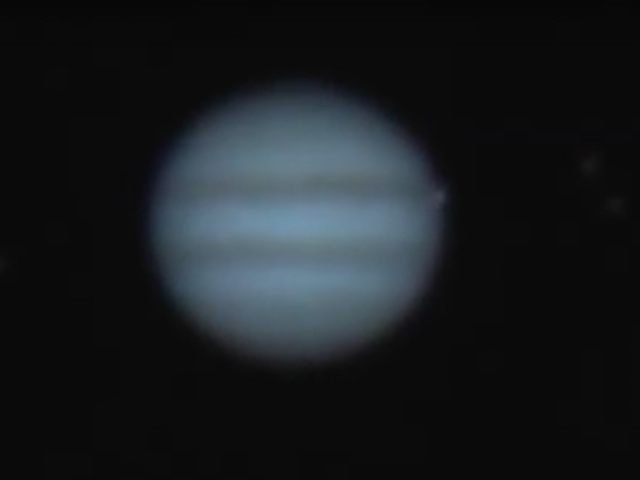Videos taken by two amateur astronomers in mid-March show a meteor strike on the rings of Jupiter that could have been a planetary extinction event if an object of similar size hit Earth.
From a distance of 365 million miles away on Earth, Gerrit Kernbauer of Mödling, Austria, posted the first video of bright flash on the outer disk of Jupiter on the morning of March 17.
Two days later, Irish observer John McKeon posted another recording of the flash.
What the two armatures apparently captured was a comet or asteroid crashing into the debris and small moons that make up rings surrounding the planet of Jupiter. The recording of the impact flash of light looks small and lasts for only a little over one second on the videos.
But looks are deceiving, because Jupiter is 86,881.34 miles wide and the equivalent of 317 times bigger than the Earth. If such an object hit the Earth, it would create the equivalent of the up to 186 mile-wide Chicxulub Crater from an asteroid that hit the Yucatán Peninsula in Mexico 65 million years ago.
The resulting explosion was likely caused by an object estimated to be about 6 miles across, and it unleashed as much energy as 100 trillion tons of TNT. That is more than a billion times the power of the atom bombs that flattened Hiroshima and Nagasaki. Many scientists believe the Yucatán explosion darkened the Earth, causing the extinction of the reign of dinosaurs. Birds are the only survivors among the dinosaur relative.
Acknowledging this existential risk, NASA announced that the United States government has just launched the Planetary Defense Coordination Office (PDCO), which will track near-Earth asteroids, develop asteroid deflection strategies, and plan FEMA response efforts if a threat arises.
“While there are no known impact threats at this time,” John Grunsfeld with NASA’s Science Mission Directorate said in a statement, “the 2013 Chelyabinsk super-fireball and the recent ‘Halloween Asteroid’ close approach remind us of why we need to remain vigilant and keep our eyes to the sky.”
NASA estimates that it has already found 90 percent of the mile-sized, dinosaur-killing asteroids in our general vicinity. But medium-sized asteroids on the order of 450-feet in diameter are much harder to spot and could still create huge damage.
“We’ve found about 40 percent of those so far,” according to Paul Chodas from NASA’s Near Earth Asteroid program, as quoted last year by Popular Science. With recent increase in funding from $4 million to $50 million, NASA’s goal is to track 90 percent of these medium-sized asteroids by 2020.
The March 17 Jupiter strike is the fifth such event in the past decade. The largest of these occurred on July 19, 2009, and it left a distinctly dark “powder burn” in Jupiter’s upper atmosphere, according to Australian astro-imager Anthony Wesley.

COMMENTS
Please let us know if you're having issues with commenting.